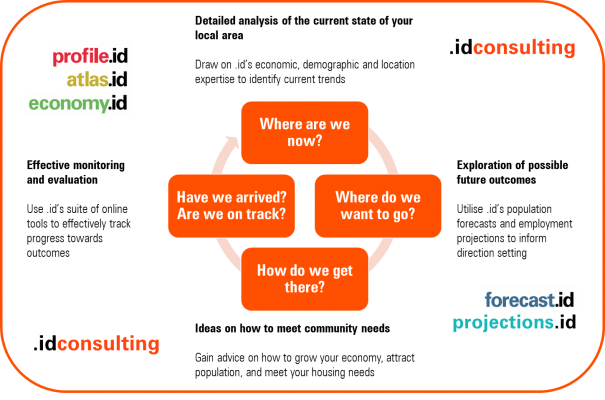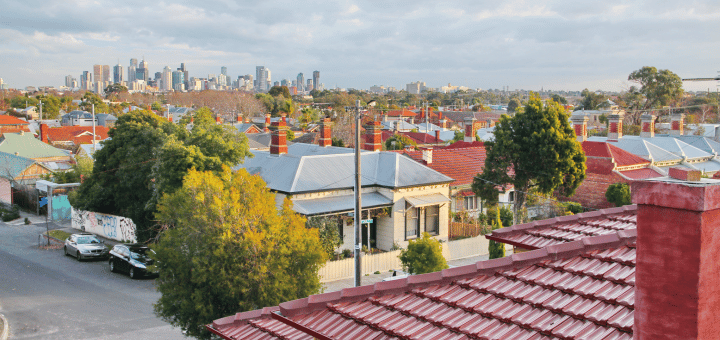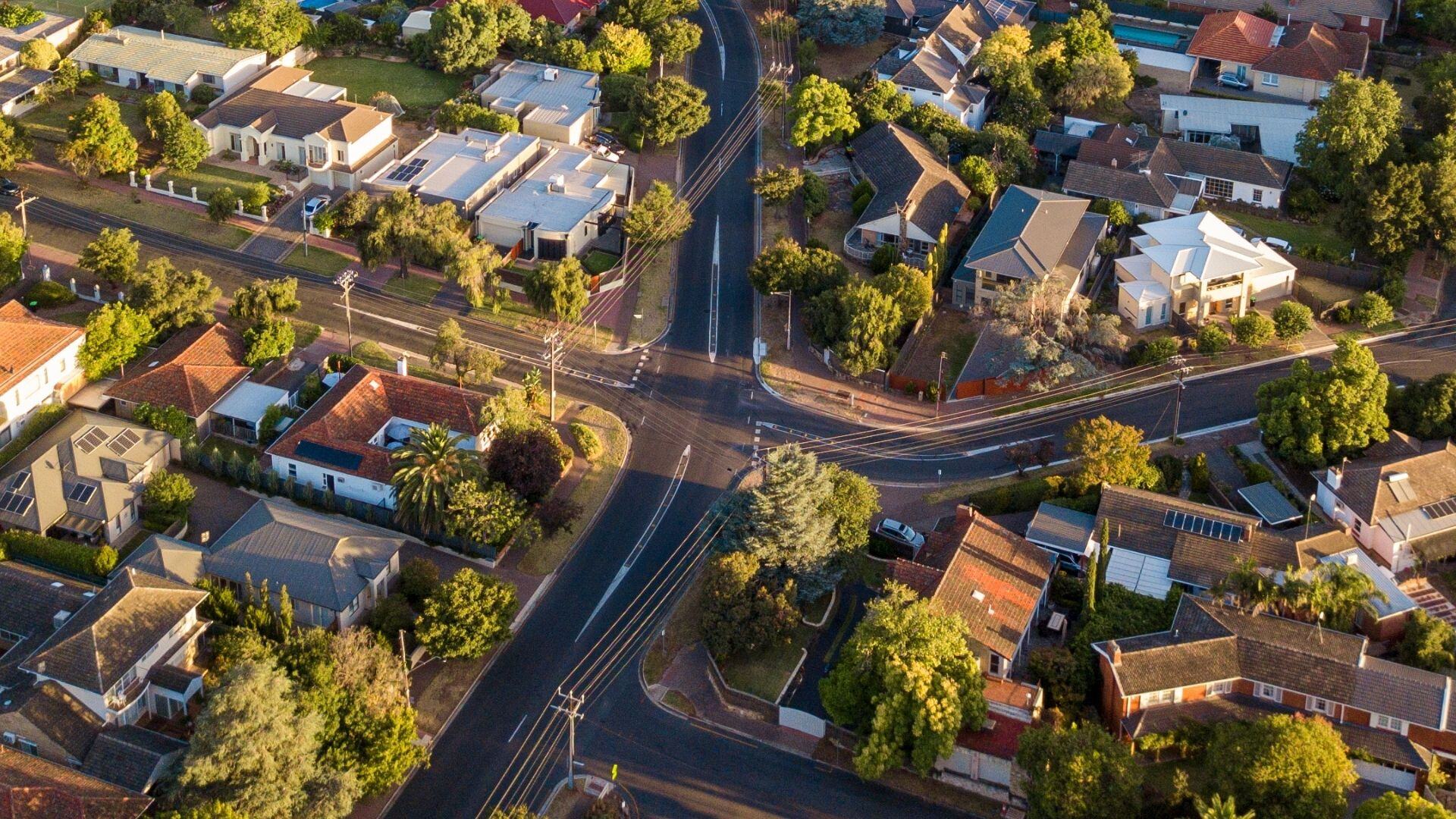This year .id had the chance to work with two different areas in Victoria’s South-West – Warrnambool and Colac Otway.
One area is a medium-sized coastal regional city that services a large share of the state’s western district. The other covers the smaller regional centre of Colac, as well as natural assets such as the Otway Ranges and a portion of the Great Ocean Road coastline.
Both LGAs have proactive councils that see the benefit in gaining an understanding of the demographic forces shaping their region to help them plan for the future.
The process of strategic planning
From our experience, strategically planning for the future, whether it be economic or community development, relies on applying a systematic process. Each stage performs a particular function and ensures a region pursues actions that seek to address identified issues or opportunities. From our experience, most successful strategies are built
In our experience, most successful strategies are built around a framework that focuses on four simple questions
- Where are we now?
- Where do we want to go?
- How are we going to get there?
- How do we know when we have arrived?

UN-Habitat (the United Nations Human Settlements Programme) developed a framework built on these core questions in the early 2000s, and it has since been utilised by local and regional organisations across the world.
The most challenging part is getting the right data and advice to help answer the questions.
.id’s tools and consulting services are specifically designed to support these questions.
The work we’ve recently done with Warrnambool and Colac Otway provided information and support to help with their strategic planning.
Where are we now?
In August, Warrnambool City invited us to present to council and their local business community as part of their State of the City: Warrnambool’s Economic Perspective event.
We were able to draw on .id’s online tools (specifically, the community profile, social atlas and economic profile), to present an overview of the city and how it compares to the broader region. As these tools have been recently updated with data from the 2016 Census, we were also able to identify up-to-date trends by comparing the latest insights with previous years.
Some things we found included that Warrnambool:
- was ageing faster than the rest of Victoria
- had a higher share of lone person households
- hadn’t seen an increase in the number of households with children
- was becoming more multicultural
- still had lower school completion rates than the state (but were improving fast), and
- households’ mortgage stress had declined but rental stress increased

Slide from the ‘State of the City: Warrnambool’s Economic Perspective’ event
This overview is useful for council planning (how do you cater for ageing demographics, how do you support new immigrants, why aren’t we attracting new families?), but also for local businesses (how do we target retirees? What skills do new migrants have?).
Colac Otway engaged us earlier in the year to provide the evidence base for the Shire’s strategic plans including the Council Plan, Municipal health and wellbeing plan and Colac 2050. As with all our profile work we like to adopt a narrative approach, rather than just presenting numbers.
What we found was a Shire losing population in its rural areas but its main centres (Colac, Apollo Bay) were experiencing some growth.
Areas on the outskirts of Colac such as Elliminyt were attractive to both young and mature families as well as older adults.
The older, more central parts of Colac attracted young adults, particularly males, seeking rental accommodation, as well as retirees and elderly persons seeking housing opportunities close to health and other services. The Great Ocean Road – Otways region attracted young adults and families, and retirees from outside the Shire. This type of analysis helps planning for community needs in specific areas.
Where do we want to go?
The future direction of a region is ultimately up to the local planners, government and community, however .id do have tools that help with this discussion.
Our population forecasts are used by a number of Local Governments to present the future of population and dwellings for their community, based on trends and bottom-up local development information.
We are also developing economic projections to provide an indication of future employment by industry (we’re currently taking expressions of interest in this product – you can register your interest if you think economic projections would be useful in planning the future of your area).
Colac Otway uses our population forecasts to identify what might happen in areas across the Shire based on current activities and trends. Any forecast is open to great uncertainty, that’s why we update them on a regular basis. They are powerful tools that prompt the region to ask questions such as;
- If we don’t like what the forecast is showing, how can we change it?
- What changes might need to be made to our service delivery to meet the needs of the forecast growth?
Colac Otway specifically drew on our consulting services to identify, based on forecast figures, the future need for education and early years facilities, and future need for assistance due to disability or old age.
How are we going to get there?
This is the core ‘planning’ part of strategic planning. What strategies and actions are you actually going to implement to bring about the future you desire?
.id’s consulting services are designed to support this stage. We have economic, demographic and planning experts that have worked with communities across Australia and overseas. We often provide advice to councils on what other regions are doing to address a community need, attract population, deliver appropriate housing and grow economies.
In Warrnambool, we presented ideas on how to address changing demographics, grow knowledge industry jobs and improve education access.
For Colac Otway, we produced a detailed analysis of enablers and constraints to growth in Colac Otway with some suggested actions:
How do we know when we have arrived?
This stage completes the loop and is often overlooked in the years after the plan is developed. However, it is a crucial step, as plans should not remain static but be reviewed and adjusted if necessary along the way.
Both Warrnambool and Colac Otway are developing a number of long-term strategic plans for their region – Warrnambool 2040 and Colac 2050 Growth Plan. Other specific service plans are developed and updated on a regular basis (economic development, community infrastructure, tourism, recreation, environment, health & wellbeing).
.id’s tools provide an effective mechanism to monitor progress against outcomes in these plans over time. We often put extra work in to ensure our data best supports this process, such as: adjusting Census data to meet boundary changes to ensure one period can be compared to another, or providing annual economic and employment estimates between Census years.
Principles for good planning
The best strategic planning processes incorporate some key principles;
- Participatory – they allow as many community members and various stakeholders to have input as possible
- Evidence-based – consistent data is used to identify opportunities and challenges, and measure progress
- Outcomes-focused – desired future outcomes are established before coming up with strategies/actions, not vice versa
- Integrated – outcomes and actions within one plan must align with and/or complement those in another plan.
Councils like Warrnambool and Colac Otway are incorporating these principles into their planning by utilising data, consulting with communities and aligning outcomes across service plans and strategies.
Can we help?
If you’re currently working on a strategic plan for your community, or you would like advice or assistance on using our tools with any stage of your region’s strategic planning process, contact one of our consultants.
.id is a team of demographers, urban economists, spatial planners and data experts who use a unique combination of online tools and consulting to help governments and organisations understand their local economies. Access our free economic resources to help profile your local economy.











